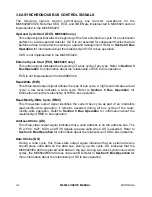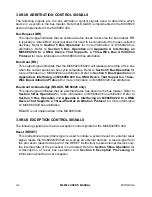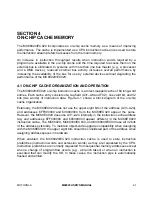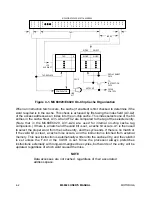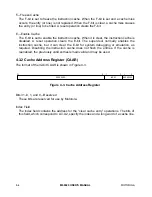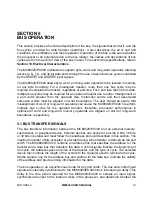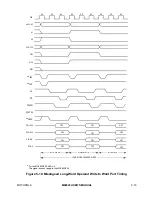
MOTOROLA
M68020 USER’S MANUAL
5- 1
SECTION 5
BUS OPERATION
This section provides a functional description of the bus, the signals that control it, and the
bus cycles provided for data transfer operations. It also describes the error and halt
conditions, bus arbitration, and reset operation. Operation of the bus is the same whether
the processor or an external device is the bus master; the names and descriptions of bus
cycles are from the point of view of the bus master. For exact timing specifications, refer to
Section 10 Electrical Characteristics.
The MC68020/EC020 architecture supports byte, word, and long-word operands, allowing
access to 8-, 16-, and 32-bit data ports through the use of asynchronous cycles controlled
by the
DSACK1
and
DSACK0
input signals.
The MC68020/EC020 allows byte, word, and long-word operands to be located in memory
on any byte boundary. For a misaligned transfer, more than one bus cycle may be
required to complete the transfer, regardless of port size. For a port less than 32 bits wide,
multiple bus cycles may be required for an operand transfer due to either misalignment or
a port width smaller than the operand size. Instruction words and their associated
extension words must be aligned on word boundaries. The user should be aware that
misalignment of word or long-word operands can cause the MC68020/EC020 to perform
multiple bus cycles for the operand transfer; therefore, processor performance is
optimized if word and long-word memory operands are aligned on word or long-word
boundaries, respectively.
5.1 BUS TRANSFER SIGNALS
The bus transfers information between the MC68020/EC020 and an external memory,
coprocessor, or peripheral device. External devices can accept or provide 8 bits, 16 bits,
or 32 bits in parallel and must follow the handshake protocol described in this section. The
maximum number of bits accepted or provided during a bus transfer is defined as the port
width. The MC68020/EC020 contains an address bus that specifies the address for the
transfer and a data bus that transfers the data. Control signals indicate the beginning of
the cycle, the address space and size of the transfer, and the type of cycle. The selected
device then controls the length of the cycle with the signal(s) used to terminate the cycle.
Strobe signals, one for the address bus and another for the data bus, indicate the validity
of the address and provide timing information for the data.
The bus operates in an asynchronous mode for any port width. The bus and control input
signals are internally synchronized to the MC68020/EC020 clock, introducing a delay. This
delay is the time period required for the MC68020/EC020 to sample an input signal,
synchronize the input to the internal clocks of the processor, and determine whether the
Summary of Contents for MC68020
Page 16: ...9 29 95 SECTION 1 OVERVIEW UM Rev 1 0 xx M68020 USER S MANUAL MOTOROLA ...
Page 268: ...MOTOROLA M68020 USER S MANUAL 9 13 Figure 9 9 Access Time Computation Diagram ...
Page 286: ...MOTOROLA M68020 USER S MANUAL 10 11 Figure 10 3 Read Cycle Timing Diagram ...
Page 287: ...10 12 M68020 USER S MANUAL MOTOROLA Figure 10 4 Write Cycle Timing Diagram ...
Page 288: ...MOTOROLA M68020 USER S MANUAL 10 13 Figure 10 5 Bus Arbitration Timing Diagram ...






